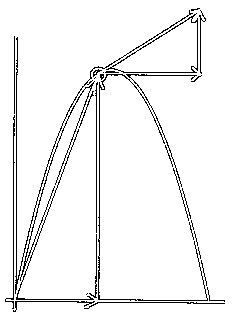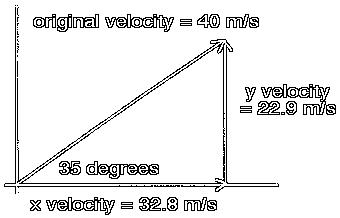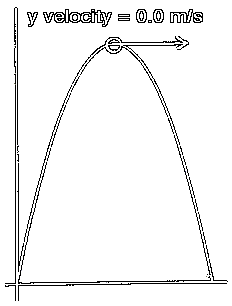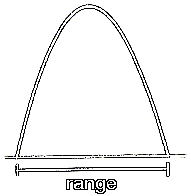Equilibrium
This is achieved when the forces of both x and y components are balanced. Therefore, we get an overall acceleration of 0, hence the object is at a state of rest.
Assumptions:
- No Friction
- No Acceleration
The forces in the y and x components of the object being acted on are balanced. Hence, we must find the x and y component of force that is acting on the object.This can be accomplished by using vectors component, when we know the force in N at a given angle.
For example:
Object B has a force of 9.2N acting on it at a angle of 70 degrees with the horizontal, therefore
Bx = 9.2 cos 70
By = 9.2 sin 70
With multiple forces acting on an object, add my x directions forces and y direction forces together to get Fnetx and Fnety.
The other forces acting on the object would be gravity. Since the forces are balanced and the object is not moving up and down, we can conclude that:
Fg = F net y, furthermore, we know that Fg = ma.
We already know that a is equal to 9.81m/s^2, therefore the mass of the object can be calculated by:
M = F nety / acceleration.
We can always check if our answer is right by calculating and see if the x direction forces are balanced as they're suppose to in an equilibrium.
Static Inclines
Assumptions:
- No acceleration
- + tive axes in the direction acceleration
- No air resistance
- fs (static friction) = µ * Fn
- Fn is perpendicular to the surface
Looking at diagram, we already know that there is no acceleration at all, therefore:
Fgx=fs, where Fgx = Mg sin
θ => Mg sin θ = M Fn
Fn=Fgy, where Fgy = Mg cos θ => Mg cos θ = Fn (sub into first equation)
Mg sin θ = µ Mg cos θ
µ = sinθ/cosθ
µ = tanθ
Kinetic Incline
In this case, the incline is almost like a static incline, except the object is moving and accelerating in the x direction. Therefore, ax does not = 0
Other assumptions:
- No acceleration in y direction
- + tive axes in the direction acceleration
- No air resistance
- fk (kinetic friction) = µk * Fn
- Fn is perpendicular to the surface
In the x direction:
Fgx - fk = ma,
Mg sin θ- µFn = Ma (1)
In the y direction:
Fn - Fgy = 0 (since acceleration is still 0), Mg cos θ = Fn (2)
Sub (2) into (1)
Mg sin θ- µ Mg cos θ= Ma
a = Mg sin θ- µ Mg cos θ / M
Pulleys
Assumptions:
- No friction from pulley, rope or any other materials in the system
- no air resistance
- Remember to draw multiple FBDs depending on situation
- Always make acceleration the positive axes in all FBDs
- T1=T2
- acceleration of the system is the same
Notice in this sample pulley problem, the positive axes is different in both diagrams because acceleration is opposite in both due to Newton's 3rd law.
For m1:
F = ma
Fₓ = ma
Fₓ = 0
Fy = m1ay
m1g - T = m1a
T = m1g - m1a (1)
For m2:
F = ma
Fₓ = ma
Fₓ = 0
Fy = m2ay
T - m2g = m2a
T = m2a + m2g (2)
By comparing equation (1) and (2)
set (1)=(2)
m1g - m1a = m2a + m2g
m1g - m2g = m2a + m1a
m1g - m2g = a (m2 + m1)
(m1g - m2g) / (m2 + m1) = a
To Find T
Sub the value of a into equation 1 or 2 to get value for T
*sometimes pulley will not necessarily be parallel to each other, they could be perpendicular or at any angle
Trains:
Assumptions:
- 1 FBD for acceleration of the whole system, where a is constant throughout the system
- multiple FBDs depending for the number of tensions there are
- ay = 0
- no air resistance
- weightless cables
- + axes in direction of a
For system acceleration:
F = ma
Fₓ = maₓ
Fₐ - f = maₓ
Fₐ - µmg = maₓ
aₓ = (Fₐ - µmg) / m
This acceleration will be same for all parts of the train. There's no acceleration in y component since we do not see the train going up and down. This is the same for all components of the train
For m1:
F = ma
F
ₓ = m1aₓ
Fₐ - T1 - f1 = m1aₓ
Fₐ - T1 - µm1g = m1aₓ
T1 = Fₐ - µmg - m1aₓ
Now there's a choice of using m3 or m2, but I think Mr. Chung said using m3 is suppose to be less likely to make a mistake. So for the sake of grade, we should stick with m3
For m3:
F = ma
Fy = m3ay
Fy = 0
Fn3 - m3g = 0
Fn3 = m3g
Fₓ = m3aₓ
T2 - f3 = m3aₓ
T2 = m3aₓ + f3
T2 = m3aₓ + µm3g
















